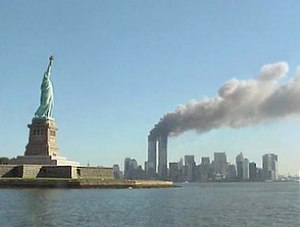 Image via Wikipedia
Image via Wikipedia Did the CIA keep mum about two 9/11 hijackers because it tried and failed to recruit them? Anthony Summers and Robbyn Swan, authors of 'The Eleventh Day,' on whether there’s any truth behind ex-Bush official Richard Clarke’s claim.
Former White House counterterrorism coordinator Richard Clarke has reignited controversy by speculating, in an interview cited in Thursday’s Daily Beast, that the CIA intentionally withheld advance knowledge of two of the 9/11 hijackers from the White House and the FBI, in an attempt to cover up the agency’s failed effort to recruit the two men as assets.
Clarke’s comments—and immediate, emphatic denials from former CIA director George Tenet and two senior CIA officials involved—go to the core of one of the enduring enigmas about 9/11.
Things began to unravel for the CIA on the day of the attacks, just four hours after the Qaeda strikes, according to research we conducted for our new book, The Eleventh Day. Soon after 1 p.m. that day, at agency headquarters in Langley, an aide handed Director Tenet the passenger manifests for the four downed airliners. “Two names,” he said, placing a page on the table where the director could see it, “these two we know.”
Tenet looked, then breathed, “There it is. Confirmation. Oh, Jesus ...”
There on the manifest for Flight 77, listed as traveling in first class, were the names of Nawaf al-Hazmi and his brother, Salem. Also on the manifest, near the front of the coach section, was passenger Khalid al-Mihdhar.
The names Hazmi and Mihdhar were instantly familiar, Tenet has said, because his people had learned only weeks earlier that both men might be in the United States. According to the director’s version of events, the CIA had known of Mihdhar since as early as 1999, identified him as a terrorist suspect by December that year, had him followed, learned he had a valid multiple-entry visa for the United States, and placed him and comrades—including Hazmi—under surveillance for a few days in Southeast Asia. Later, in the spring of 2000, the agency had learned that Hazmi, who also had a multiple-entry visa, had arrived in California.
The director said after 9/11, though, that—in spite of having gained such dynamite information—the CIA had done absolutely nothing about it. The agency had not asked the State Department to place the two terrorists on watch lists at border points, nor asked the FBI to track them down if they were in the United States—not until 19 days before 9/11. The omission, according to the CIA, was simply the result of multiple mistakes.
Historical puzzles are as often explained by screw-ups as by darker truths. What is known of the evidence on Hazmi and Mihdhar, however, makes the screw-up version hard to swallow. Not least because the CIA version of events suggests its officials blew chances to grab the two future hijackers time and time and time again.

